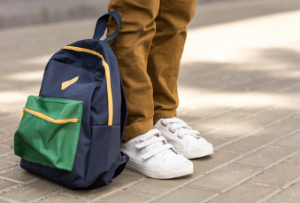There are several factors to consider before buying a pair of school shoes. For example, consider whether your child will need no-lace or slip-on shoes. Next, consider the upper: leather or mesh. A shoe with a lace-up or Velcro closure is more secure than a slip-on shoe. Finally, a shoe with a worn-out tread may be too slippery or uncomfortable. Look for worn-out tread or holes in the toes or heels, indicating that it’s time to size up.
No-lace shoes
 No-lace school shoes are a good option for children, especially if they’re a little older. The older kids may prefer to wear them anyway, and teens may find them more comfortable. However, if you’re worried about your child’s safety, consider buying no-lace shoes for them. Here’s a guide to help you choose the right kind of shoe for them. Also, consider their age – a child who is not yet a year old should not wear lace shoes.
No-lace school shoes are a good option for children, especially if they’re a little older. The older kids may prefer to wear them anyway, and teens may find them more comfortable. However, if you’re worried about your child’s safety, consider buying no-lace shoes for them. Here’s a guide to help you choose the right kind of shoe for them. Also, consider their age – a child who is not yet a year old should not wear lace shoes.
A great pair of Everflex AU no-lace shoes for kids will keep their feet dry and protected. These black faux leather shoes have a stretch gusset across the bridge of the foot for added comfort and stretch. They also have an antibacterial lining and sock that keeps feet fresh. Kids won’t get too muddy in these shoes, but they will feel great when they get home from school. They’ll have an easy time keeping these shoes on for hours!
Comfortable slip-on
There are many benefits to wearing a pair of comfortable slip-on for school. For instance, you don’t have to worry about tripping or feeling uncomfortable in them. Most models are made with an anatomical cushioned sole and a soft micro-suede lining. The lightweight design also makes walking in and out of them easier. You can also purchase a comfortable school slip-one that will last for years.
Leather uppers
The leather upper of Everflex AU school shoes provides your child’s feet with the support they need throughout the day. School shoes should not be as lightweight as running shoes or other athletic footwear. While leather shoes are less supportive than running shoes, they are also more durable. If you’re concerned about how the school dress code will affect your child’s clothing, check the dress code guidelines before you buy a pair of school shoes. Additionally, leather uppers keep the feet cooler and protect them from the weather.
Traditional school shoes come in a wider range of sizes and half sizes. For example, the Daytona style comes in six widths and half sizes from junior to senior. A leather upper on a school shoe is a classic choice for a comfortable fit. The shoes are designed for long-term use, so they’re a good investment. They can be found in various colours and won’t hurt your child’s feet.
Mesh uppers
While leather and mesh uppers are both flexible, the latter is usually more durable and lightweight, so you may need to compromise. Leather school shoes are better than mesh ones because they have a more durable upper, while mesh ones are more breathable. A shoe’s upper and midsole should be supportive, as the support is essential for the arch of your child’s foot. A wide base is necessary to distribute weight evenly and provide arch support. The midsole is also crucial for arch support, as overpronation can cause numerous injuries and pains.
While mesh uppers are an excellent choice for Everflex AU school shoes, they can wear out faster, so make sure they are designed to last. Black sneakers, for example, are often suitable for primary and kindergarten use, but black mesh-upper ones should be avoided. Remember to get your child fitted in the store for proper fit. You want the toes to move freely in the shoe without squashing from the sides or the top.
Measuring on the outside of the shoe
In a recent study, researchers from the University of Cape Town in South Africa and the University of Salford in the United Kingdom reported that fifty-nine per cent (59%) of children wore shoes with an incorrect length. Despite the study’s limitations, it did advance the knowledge of the barefoot population. It suggests that shoe manufacturers need to make fundamental measurements more precise. If the forefoot is too wide, children in poorer socioeconomic areas will not have the option of buying a wider pair of shoes.